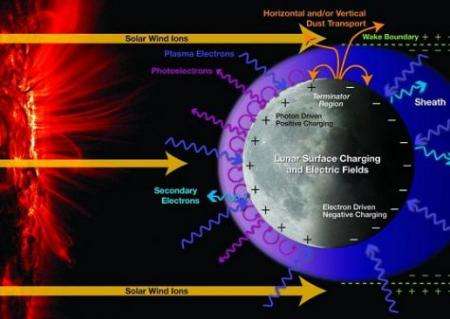Lunar surface charging and electric fields caused by sunlight and solar wind. Credit: Jasper Halekas and Greg Delory of U.C. Berkeley, and Bill Farrell and Tim Stubbs of the Goddard Space Flight Center.
Moondust is dry, desiccated stuff, and may seem like a dull topic to write about. Indeed, you could search a ton of moondust without finding a single molecule of water, so it could make for a pretty "dry" story. But like the dust in your mother's attic, moondust covers something interesting – the moon – and even the dust itself has curious tales to tell.
A group of NASA and University of Alabama researchers are what you might call "active listeners": Mian Abbas, James Spann, Richard Hoover and Dragana Tankosic have been shooting moondust with electrons, levitating moondust using electric fields, and scrutinizing moondust under an electron microscope. All this is happening at the National Space Science and Technology Center's "Dusty Plasma Lab" in Huntsville, Alabama.
Why such attention? Spann explains: "Humans will return to the moon in a few years and have to know what to expect. How do you live and work in a place filled with moondust? We're trying to find out."
"Moondust was a real nuisance for Apollo astronauts," adds Abbas. "It stuck to everything – spacesuits, equipment, instruments." The sharp-edged grains scratched faceplates, clogged joints, blackened surfaces and made dials all but unreadable. "The troublesome clinginess had a lot to do with moondust's electrostatic charge."
Dust on the moon is electrified, at least in part, by exposure to the solar wind. Earth is protected from the solar wind by our planet's magnetic field, but the moon has no global magnetic field to ward off charged particles from the sun. Free electrons in the solar wind interact with grains of moondust and, in effect, "charge them up."
At the Dusty Plasma Lab, the scientists simulate solar wind-like conditions to study the moon's dust in a realistic environment. In previous studies, Abbas and colleagues examined the effects of ultraviolet sunlight on grains of moondust to help construct theories about how moondust will behave during daylight hours on the moon. (UV photons can also charge up moondust.) Now they are investigating how the grains behave in the dark of night, when the swirling solar wind dominates "lunar weather."
"Fortunately, we know what the solar wind is like, so we can simulate it," says Spann.
In a typical experiment, Abbas peppers the dust grains with a beam of electrons from an electron gun. He suspends a single grain of moondust inside the vacuum test chamber and bombards the grain with different numbers of electrons.
"We've had some surprising results," says Abbas "We're finding that individual dust grains do not act the same as larger amounts of moon dust put together. Existing theories based on calculations of the charge of a large amount of moondust don't apply to the moondust at the single particle level."
When it comes to electrostatic charging, grains of moondust are individualists capable of eccentric and surprising behavior. For instance, in one experiment conducted by Abbas, pelting a positively charged grain of moondust with electrons (which carry a negative charge) caused the grain to exhibit a more positive charge. Consider that grain a contrarian! Abbas thinks that each electron hitting the grain dislodged two or more electrons already there, resulting in a net increase of positive charge.
Not all moondust behaves this way. How each grain reacts depends on a variety of factors including the grain's size, the charge it already carries, and the number of free electrons incoming.
Spann adds, "We believe the single grains will behave differently on the moon, too – not just in our lab. Our results are closer to what's really happening on the moon. We're saying, 'Hey wait a second guys. We're finding something odd. When you go to the moon, it's going to be a little different than you thought.'"
You can bet mission planners will be listening as the moondust tells its tale.
Source: Science@NASA, by Dauna Coulter
























